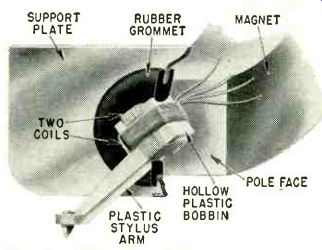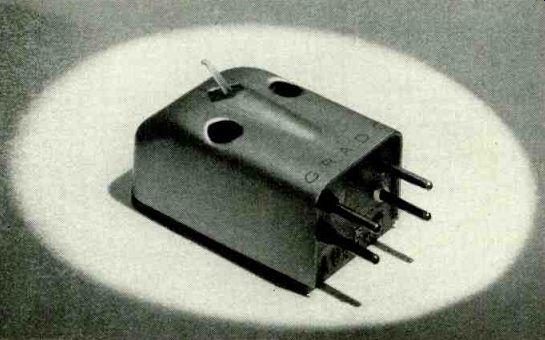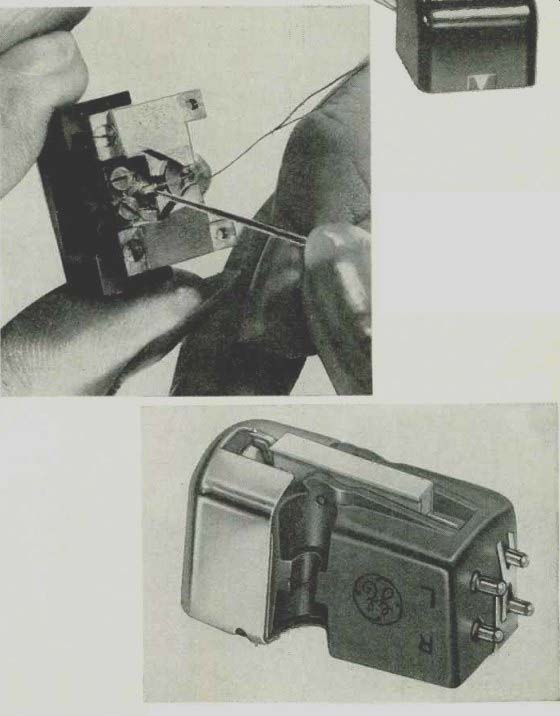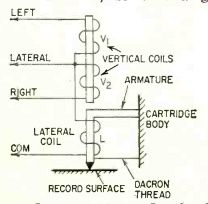Part II--The Grado Master, Neumann DST Dynaco TA-I2, G-E VR-22, London-Scott
1000
By JULIAN D. HIRSCH
IN pre-stereo days, many of the finest phonograph cartridges used a moving coil as their generating element.
Although moving-coil cartridges in general have lower output voltages and tend to be more fragile than other types, their lower impedance makes them relatively immune to induced hum (from nearby phono motors or power transformers) as well as to the shunting effects of cable capacitance at high frequencies.
At present, there are few moving-coil stereo cartridges. Two of these, both of very high quality, are the Grado and the Neumann.
Grado The original Grado stereo cartridge (now called the Master) was described in RADIO-ELECTRONICS (November, 1958, page 88). Current production models of the Grado Master, though similar in construction to the unit described in the earlier article, have been further refined. The two coils, each of 1,000 turns of extremely fine wire, are wound on a hollow plastic cube approximately 1/16 inch square, which is molded in one piece with the stylus arm (Fig. 1) . The coil assembly is mounted in a special rubber grommet which provides uniform compliance in all planes.
The coils are located in a uniform field supplied by a powerful permanent magnet. When the coil structure rotates, a voltage is generated in each coil (proportional to the recorded velocity in the corresponding channel). The new Master cartridge has an output of 6 mv at 10 cm /sec. The effective stylus mass has been cut in half, from 0.8 to 0.4 milligram, which, in turn, extends the high frequency response of the cartridge. The manufacturer's specifications for frequency response are 1050,000 cycles (with no tolerance specified). In other respects, the present Grado Master cartridge is identical to the earlier models. The two outputs are balanced to within 0.5 db over the audio range. Recommended tracking force is 3 grams and the load resistance is noncritical so long as it is greater than 5,000 ohms. Channel separation is greater than 25 db. A tiny radioactive element embedded in the case of the cartridge behind the stylus ionizes the air in the vicinity of the record surface.
Static charges are reduced and so is the amount of dust that accumulates on the record.
The Grado Custom stereo cartridge is a less expensive version of the Master for use in record changers. Its coils are wound with more turns of slightly heavier wire. The output, therefore, is greater than that of the Master series--approximately 7 mv at 10 cm /sec.
SUPPORT PLATE RUBBER MAGNET GROMMET PLASTIC SARM S

Fig. 1--The coil bobbin and stylus arm of the Grado Master are one piece.
HOLLOW POLE FACE PLASTIC BOBBIN
The effective mass at the stylus is 0.6 milligram (reducing the claimed upper limit of frequency response to 40,000 cycles) . Channel separation is in excess of 20 db. In all other respects, the Grado Master and Custom cartridges are similar.
The Grado Master cartridge is priced at $49.50 and the Custom at $32.50. Neumann DST The Neumann DST stereo cartridge is the product of á West German manufacturer of professional-quality microphones (sold in this country under the names of Telefunken and Neumann). It is imported by Gotham Audio Sales Co., 2 W. 46 St., New York 36, N. Y. The Neumann cartridge is a moving-coil type with a tubular torsion bar mounting the stylus at one end and the two generating coils at the other end.
The entire stylus bar is covered by a thin rubber membrane (visible in the photo). This membrane serves a triple purpose: It keeps dust and foreign matter from entering the cartridge, protects the delicate moving system from damage and provides a slight amount of stylus damping. Only the stylus jewel protrudes from the rubber membrane.
The impedance of the DST cartridge is extremely low-about 18 ohms-and it will work satisfactorily into any load impedance greater than 50 ohms. The output is correspondingly low, 1.05 mv at 7 cm /sec. This makes a stepup input transformer a virtual necessity. Gotham offers the Beyer TR147C transformer which has a 15-to-1 stepup ratio and a response from 30 to 20,000 cycles within 1 db. Two are needed for stereo operation.
The frequency response of the Neumann DST cartridge is 30 to 15,000 cycles ±2 db. Channel separation exceeds 30 db at mid-frequencies (1,000 to 3,000 cycles) and is better than 12 db at 10 khz. The stylus-system compliance is 3.6 x 10-8 cm /dyne. The recommended tracking force is 4 grams and the stylus is a diamond with a 0.6-mil tip radius.
The DST is designed to fit arms having the plug-in connection used on some professional European equipment. Typical arms are the Neumann TA-2 or the Danish Ortofon (known in this country as the ESL Professional).

Fig. 2--Exploded view of Stereodyne II.
The price of the Neumann DST stereo cartridge is $69 and the TA-2 transcription arm is an additional $105.
The Beyer TR147C transformers are $15.95 each.
Variable reluctance
The variable reluctance principle (pioneered by General Electric in its early monophonic pickups) is still widely used in stereo cartridges. In a variable-reluctance cartridge, a fixed magnet supplies a magnetic field which inks two or more fixed coils (in a stereo cartridge). An air gap is built into the magnetic circuit and the stylus moves an iron armature to vary gap width.
This causes a change in reluctance (the magnetic equivalent of electrical resistance). The flux variation through the coils generates a voltage proportional o the stylus velocity. Thus, the name-variable reluctance.
Dynaco TA-1 2
The Dynaco B &O Stereodyne II carridge is virtually identical to the one described in RADIO-ELECTRONICS, March, 1959, page 83. It has four coils and four pole pieces arranged to form a square (Fig. 2). The stylus moves an X-shaped armature, varying the flux to the two oil sets.
The chief changes in the present Stereodyne models have been to improve he stylus system damping. The same basic cartridge, however, has been incorporated into an interesting integrated pickup design known as the TA-2.
The arm is tubular with the front portion angled downward and inward to place the stylus in contact with the record at the proper angle. The cartridge, identical internally to the regular Stereodyne II, plugs into the end of the arm. Together they make a strange-looking combination.
The pivot design of the Dynaco arm resembles the gimbals used to support the rotor of a gyroscope. The inner ring is pivoted at top and bottom to allow lateral arm motion while the arm itself is pivoted from the sides of the inner ring for vertical motion.
The counterweight at the rear of the arm exactly balances the cartridge and is offset to the side opposite to the head offset. As a result, the arm (being fully balanced) is not affected by a turntable that is jarred or is not level. The downward tracking force is derived from a spring whose tension is adjusted by sliding a plastic collar along the arm.
Calibration lines indicate stylus force (from 1 to 4 grams). The manufacturer recommends a force of 2 to 3 grams, which is enough for most installations.
The cartridge leads run through the pillar supporting the pivot assembly and are fully shielded. Since the cartridge is encased in Mumetal, the result is a very low hum level.
The frequency response of the Dynaco TA-12 is rated at 30 to 15,000 cycles ±3 db. The output voltage is 7 mv per channel at 5 cm /sec. The compliance is 5 x 10-° cm /dyne in all directions due to the symmetrical design of the cartridge. The moving mass is less than 3 milligrams. Recommended load resistance is 47,000 ohms.
Price of the Dynaco TA-12 integrated stereo pickup is $49.95.
G-E VR-22 The VR-22 is the improved version of the G-E model GC-5 and GC-7 stereo pickups (RADIO-ELECTRONICS, October, 1958, page 49). In all fundamental respects, the new cartridge is identical to the original version.
The VR-22 series is available in two models, the VR-225 with a 0.5-mil diamond stylus for quality pickup arms and the VR-227 with a 0.7-mil stylus for record changer operation.
The stylus assembly of the VR-22 cartridge has been improved-a new damping-block design improves tracking of high-level passages. Mu-metal shields around the top and front of the cartridge, as well as the coil assembly, minimize hum pickup.
Most of the performance specifications of the VR-22 are identical to those of the original Golden Classic cartridges. A notable improvement has been made in channel separation (which is as great as 30 db at mid-frequencies) and in channel balance. The outputs of the two channels are within 1 db of each other at 1,000 cycles and are closely matched over the entire frequency range.
The response of the VR-225 is rated at 20 to 20,000 cycles ±3db, and the VR-227 at 20 to 17,000 cycles ±3 db.
The output of both cartridges is 6 mv per channel at 5 cm /sec. The lateral and vertical compliances of the VR-225 are 4 x 10^-8 cm /dyne and 2.5 x 10^-° cm /dyne respectively. For the VR-227, the compliances are 3 x 10-° cm /dyne and 2 x 10' cm /dyne. Recommended tracking forces are 2 to 4 grams for the VR-225, and 5 to 7 grams for the VR227.
The price of the VR-225 is $27.95; the VR-227, $24.95.
London-Scott 1000

------------ The Grado Custom.
----------

Dynaco Stereodyne TA-12.
London-Scott mounted on its arm.

Drop of cement is used to fasten the Dacron thread to the London-Scott
cartridge body.
General Electric VR-22.
----------------
In an earlier article (RADIO-ELECTRONICS, November, 1958, page 83), the London-Scott 1000 integrated pickup was described briefly. It had just been introduced and only sketchy information was available. This British unit is unique in being a true vertical lateral pickup instead of the 45-45 type we are accustomed to.
The arm is anodized aluminum with needle type pivots in the vertical and ball bearings in the lateral plane. Its height can be adjusted to accommodate various turntables. The counterweight is factory-set for a 3.5-gram tracking force. A small amount of viscous damping is used in the arm to damp its low-frequency resonance (which occurs at 14 cycles). The cartridge clips on to the arm.
The London-Scott 1000 is a variable-reluctance pickup. Two sets of coils are linked by the cartridge's magnetic field.
The L-shaped armature is of magnetic material and forms a part of the magnetic circuit for both sets of coils.

Fig. 3--Interior of the London-Scott 1000 showing coil connections.
Fig. 3 is a simplified sketch of the pickup. The complete magnetic structure, including pole pieces, is not shown.
The single lateral coil and two vertical coils are identical, so that a given stylus velocity in the appropriate plane will generate the same voltage in its corresponding coil. The two vertical coils are connected in opposition with their junction connected to one side of the lateral coil. The other end of the lateral coil serves as a common output lead for all signals.
A purely lateral motion of the stylus will induce a voltage in the lateral coil, but not in the vertical coils. Under these conditions, the same output voltage will appear at all three output terminals (LEFT, RIGHT and LATERAL). On the other hand, a purely vertical stylus motion will not generate a voltage in the lateral coil, but will develop equal and opposite voltages in the two vertical coils.
= = =
Also see:
International Dictionary of Applied Mathematics (ad)
Radio-Electronics-- (USA print magazine)